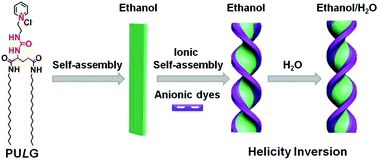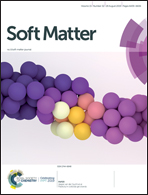Water inversed helicity of nanostructures from ionic self-assembly of a chiral gelator and an achiral component†
Abstract
The ionic self-assemblies (ISAs) formed by a cationic chiral organogelator (L-glutamide amphiphile, abbreviated as PULG) and anionic dyes exhibited helical nanostructures. And the formed helical structures can be tuned by water amount in the ethanol/water solvent. In pure ethanol, the chirality of the gelator was successfully transferred to the achiral components, which was confirmed by the appearance of an induced CD signal in the achiral components. Meanwhile, the electrostatic interaction between the gelator and achiral dyes contributed to the chirality amplification, causing the nanofibrous structures of the gelator to be transformed to uniform left-handed helices. Upon adding water to ethanol, the induced CD signal exhibited inversion from positive to negative. Interestingly, the left-handed helices formed by ISA of PULG/anionic dyes in ethanol were inverted to right-handed helices with the addition of water. Based on detailed investigations of the XRD patterns, CD and UV/Vis spectra, the mechanism of helicity inversion was proposed: left-handed helices were dominated by hydrogen bonding and right-handed helices were dominated by π–π stacking. This work exemplifies a feasible method to invert the helicity of chiral nanostructures in co-assembly and gives an insight into the conformation change of biomacromolecules in a biological system.



 Please wait while we load your content...
Please wait while we load your content...